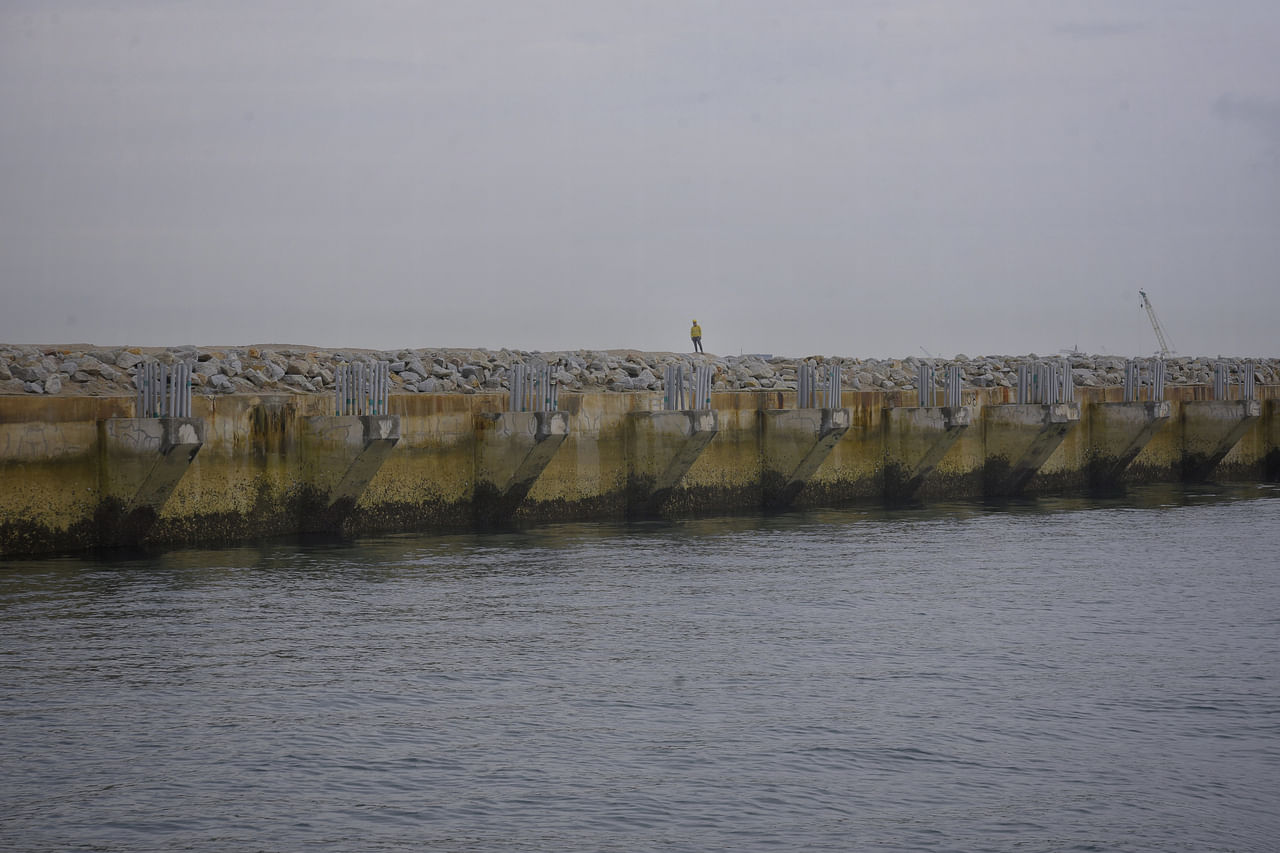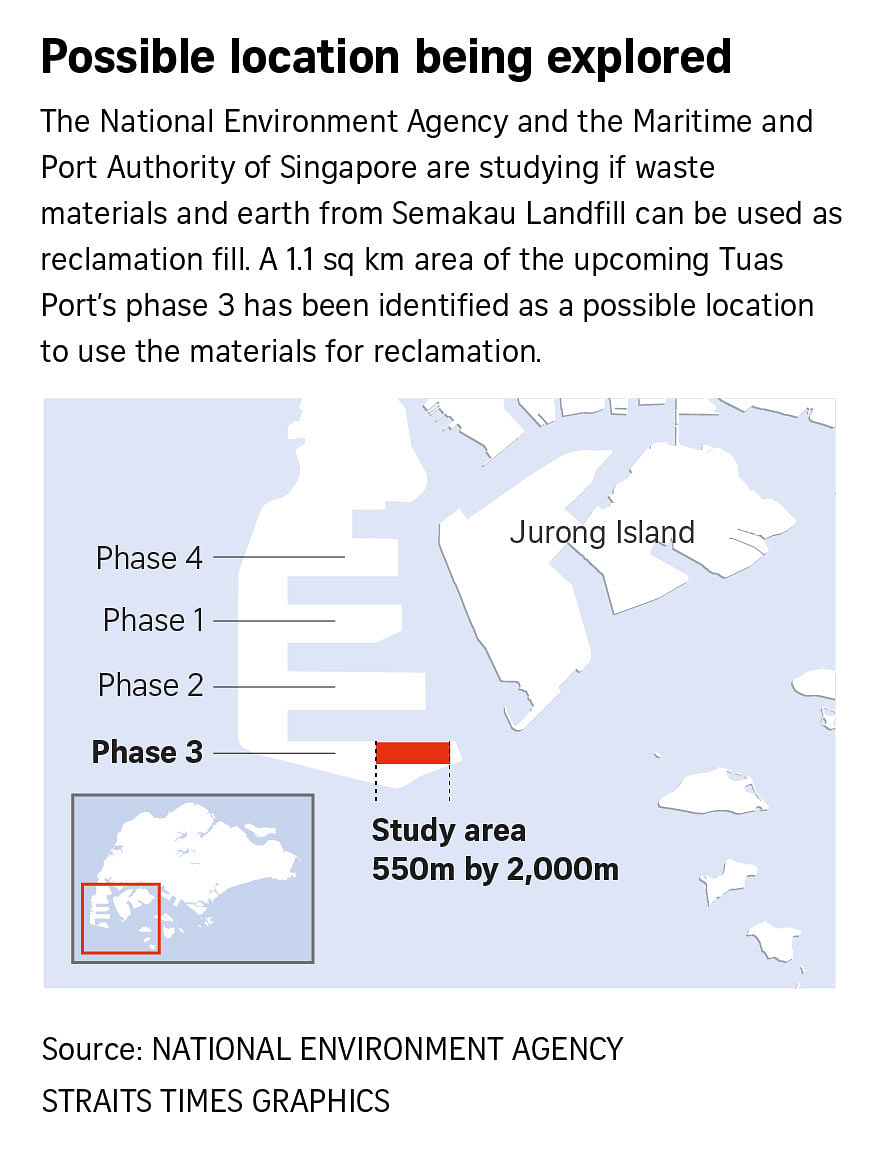SINGAPORE - Incinerated ash and other waste materials from Semakau Landfill could be used for reclamation works in the third phase of Tuas Port's development.
The National Environment Agency (NEA) and Maritime and Port Authority of Singapore (MPA) will conduct an environmental safety and technical feasibility study to use waste materials recovered from the landfill for land reclamation.
Using suitable landfilled materials as reclamation fill will free up landfill space at Semakau Landfill and reduce the need to import reclamation materials, NEA and MPA told The Straits Times in a joint statement on Sunday (Nov 7).
"Doing so presents an opportunity to rethink land reclamation and waste materials to improve Singapore's resource sustainability and resilience, and bring us closer to achieving a circular economy," they said.
Located 8km south of the mainland, Semakau Landfill on Pulau Semakau is Singapore's only operating landfill. It began operations in 1999, and is currently expected to be full by 2035.
NEA and MPA said they will have a better estimation of the amount of landfilled materials that could be excavated after the feasibility study is completed.
The year-long study is slated to begin in the first quarter of 2022, and will take place in stages.
Consultants will first assess the characteristics of mixed materials, which comprise incineration ash and non-incinerable waste that are disposed of in Semakau Landfill, such as big appliances, bulky and long metal objects, and bulky wood waste.
They will then have to develop several concept designs for an "impermeable containment space" within a 550m by 2,000m area to house the mixed materials as part of phase three in Tuas Port's development.
Next, consultants will study how the containment space can be built and reclaimed, as well as assess the environmental impact of using mixed materials for reclamation.
The study will conclude with consultants devising how to excavate, process and transport mixed materials, before they decide which concept design will work best.
This study complements NEA's ongoing work to develop processes that will turn incineration bottom ash - residue from the burning of waste in incineration plants - into a product for non-structural concrete and road production.
Recycled materials have also been used in earlier stages of the Tuas Port project. MPA said in June 2020 that more than half of the total fill materials for reclamation works in phase one and two were recycled, generating more than $2 billion in savings on fill material costs.
Experts said that while the use of waste soils for reclamation is not new, ensuring that pollutants will not leak into the water will be of utmost importance as the feasibility of the project is assessed.
Professor Yong Kwet Yew of the National University of Singapore's (NUS) Department of Civil and Environmental Engineering said municipal waste and waste soils have also been used in reclamation overseas, such as for Japan's Port of Osaka.

Given the challenges in securing supplies of sand, which has been the favoured reclamation material for projects here, he said the study is timely as many future reclamation projects will be in deep waters requiring large volumes of landfill.
"The search for alternative fill materials by Singapore agencies has been ongoing since the 1980s," Prof Yong added.
Meanwhile, Assistant Professor Huang Danwei of NUS' Department of Biological Sciences said mixed landfilled materials could contain heavy metals and other chemical and microbial content that might pose significant risks to human and environmental health if released into coastal waters.
He said the waste at Semakau Landfill is known to contain arsenic, which is carcinogenic, as well as mercury and lead that can harm people's cardiovascular and central nervous systems.
"Exposure of marine organisms and ecosystems to these chemicals can certainly cause irreparable damage," said Prof Huang, a marine biologist
He said exposure could happen at multiple stages of the reclamation process, including during the extraction of materials from the landfill, the transportation to Tuas Port, and filling process, as well as long-term leaching.
He said the long-term efficacy of the impermeable containment space should be scrutinised, especially as the service life of the container terminal is about 60 years - much longer than the length of the study.
During its lifespan, chemical changes within the mixed materials may raise the toxicity of compounds within the reclaimed area, or even increase the fill's ability to leach out of containment, Prof Huang said.
He noted: "Long-term monitoring and contingency management plans are essential, not just to prevent leaching and contamination, but also to ensure that marine habitats and the ecology in the vicinity are not adversely affected throughout the service life of the reclaimed terminal."
Prof Yong agreed that knowing the chemical composition of the mixed materials was important. He said such compositions could vary across different contexts, justifying the necessity of the study.
Findings on chemical hazards and properties of the materials will guide the construction of appropriate impermeable barriers to prevent leaching, he said.



